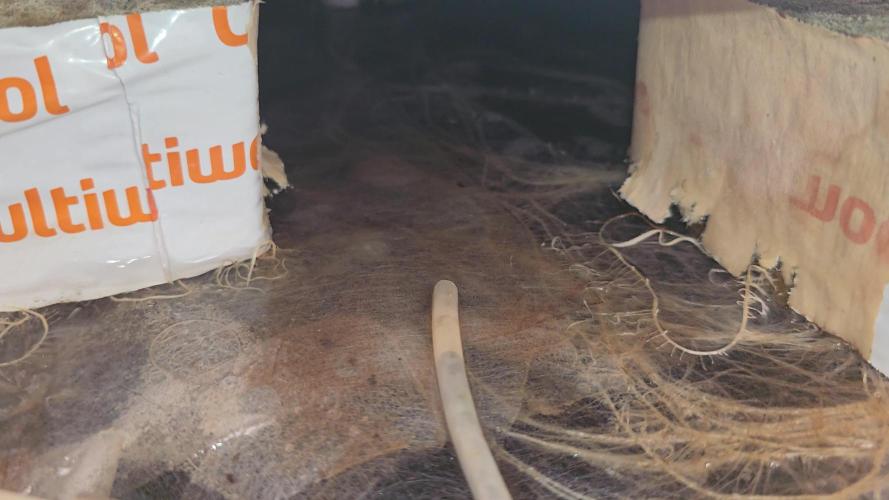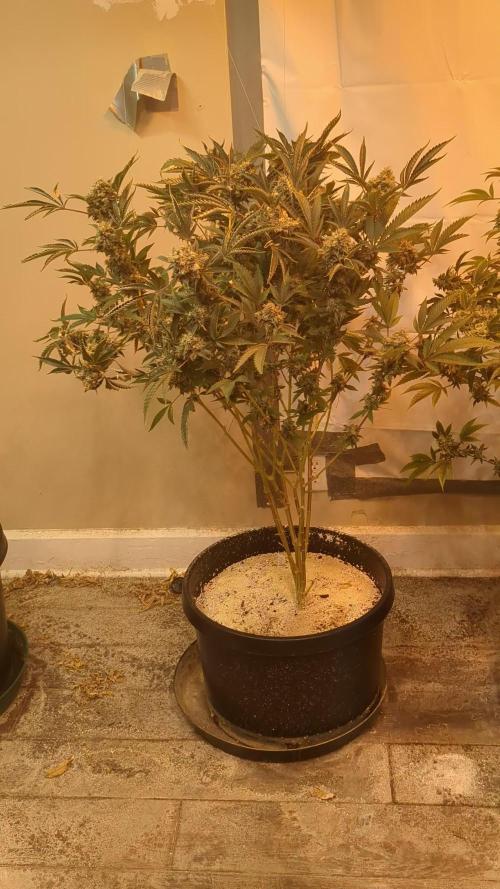The Grow Awards 2026 🏆 





























Likes
Comments
Share


@BombBuds
Follow
Letzte Woche!
Einmal noch gießen aber nur wenig damit die bissl trockenstress haben und trichome nochmal anziehen.
Keinen Dünger mehr und nur noch ph neutrales Wasser.
Geruch ist super geil! Aussehen ist auch ne 10/10. bin sehr gespannt aufs Endprodukt!
Likes
13
Share


@DonKrika
Follow
Similar conditions as last week, but the plant is getting bigger, so is drinking more, I was finally able to feed the plant 2 times in one week.
This week I also introduced a foliar spray. I applied the foliar spray 1h after the lights turned off, next time I need to give it a bit earlier, right after the lights turn off.
I also used Mycorrhizae this week as well
I feel that the initial problems that I had been solved, the plant is growing at a normal pace now.
DAY 30 - Water
PH - 5.80
PPM- 531
Solution Temp - 22
Watering Volume - 2L
DAY 33 - Nutes
PH - 6.02
PPM- 1600
Solution Temp - 21
Watering Volume - 1.2L
Foliar Spray
PH - 5.21
PPM- 1450
Solution Temp - 21
Watering Volume - 100 ml
Likes
8
Share


@Dapper_Buds
Follow
Week 6 and these girls got a scrog net added. As the plants are getting extremely heavy. Started to unfold an open up eagle spread style. So had to lend a helping hand. They got a scrog net added an the untrained plant got tied up from tents upper support bars an lower branches got some support also from the net. So far everything is going smoothly. The e680s light is putting in that work work
Likes
16
Share


@DudeGrowsWeed
Follow
Stopped adding nutrients 2 weeks ago due to slight nutrient burn. Also I am growing in an organic composted 'super soil' that should have plenty of nutrients of its own (probably partly why I saw some nutrient burn after adding additional nutrients). Trichomes look nice and milky. Probably harvesting this week.
Likes
184
Share


@Still_Smoq
Follow
#seedsman420growoff and #SeedsmanSeeds
📆 Week 3, 11-17 May 2024
11 May - Increased light power to 60%.
12-17 May - Observed and let the plant grow.
📑 Increased light power to 60% to get DLI 25 coverage on the plant. Made adjustments to lower branches moving them through leaves. The plant seems to be on its way to keeping a uniform height without any training.
🍶 11 May nutrient solution changed
🍽️ 11 May feeding schedule updated
💧 Using reverse osmosis water with EC/TDS at 0
🐉 Nutrient Solution EC 1.6 at 70 degree F
🔆 Light power 60%, DLI 25 canopy coverage at 18hrs
😤 Using General Hydroponics, HGC728040, Dual Diaphragm Air Pump, 320 GPH
That is it for this week. Thanks for the look, read and stopping by.
Likes
30
Share


@XperencdGmanXG
Follow
more liquid seaweed foliar spray and Silica. Pre flower has not started on this plant yet, prob due to the fact it was put out 2 week later than the rest which are in full pre flower. plant has grown a whopping 18" this week. Amazing!
Likes
13
Share


@Weedy_Shepherd
Follow
These buds are just massive.. There's no other words to describe them!!.. Smells very fruity with a pine smell in the background.. The great OG Kush is still a lit bit back in bud formation but am really excited to see her in late stage of flower one monster of a plant!!
Likes
20
Share


@DreamIT
Follow
Sponsored by:
🎆ANESIA SEEDS🎆-💡VIPARSPECTRA💡-💐GREEN BUZZ LIQUIDS💐-🛠️WEDRYER🛠️
28/7 they grow monstrously well, next week they come into bloom
2/8 it took a few days of absence to discolor the leaves and dry out the soil. Today I will be watering properly with Green buzz nutrients fertilizers before sending them into bloom
__________________________________________
Personal advertising (contains affiliate links)
__________________________________________
🦄 The varieties of Anesia seeds all have an extremely high content of THC and cannabinoids. They were bred specifically for the effect and therefore find wide applications for medical purposes as well.
✅https://bit.ly/Anesiaseeds_
__________________________________________
Did you know that Green Buzz Liquids fertilizers are 100% vegan? A complete line of products ready to give the best to each of your plants! Visit the site and see my journals to see how they work 🦄
🤯 And with the code "dreami t" you will immediately receive a 15% discount on your purchases
✅https: //bit.ly/GreenBuzzLiquidsPro
__________________________________________
👀 Are you looking for a good lamp to start with? 👀
🌞Viparspectra has something more than the others, take a look at their site.
⏩ Use "GDVIP" for an extra discount on amazon or "DREAMIT3" for an extra 5 %% discount
👀 Search for it on Amazon
✅Amazon USA: https://amzn.to/30xSTVq
✅Amazon Canada: https://amzn.to/38udUVe
✅Viparspectra UE: bit.ly/ViparspectraUE
✅Viparspectra USA: bit.ly/ViparspectraUS
______________________________________________
🌈 Tired of blowing on your weed hoping it dries quickly? Check out the Wedryer website! You will find a well-made accessory that will help your weed dry in just 8-10 days without the annoying risk of finding mold or other annoyances! (no affiliate links)
✅https: //bit.ly/Wedryer_
______________________________________________
📷🥇Follow the best photos on Instagram 🥇📷
https://www.instagram.com/dreamit420/
Backup
https://www.instagram.com/dreamit4200/
🔻🔻Leave a comment with your opinion if you pass by here🔻🔻
🤟🦄💚 Thank you and good growth 💚🦄🤟
Likes
11
Share


@Drgreenthumb627
Follow
This one was a huge surprise because up to this point i had thought it was a completely different plant, blueberry cupcake. one of two seedlings had died and i didn’t have them properly marked. its growing great but clearly has a long way to go before finishing. smells like pine, funk, and a hint of citrus
Likes
9
Share


@Colo420
Follow
17/12 se realiza fertiriego.
19/12 se podan los 2 primeros nudos, se hace poda apical y se transplanta de 1 a 3L con aplicacion de micorrizas
Likes
6
Share


@Kendoda
Follow
Things are generally going ok. I’m going to reduce the bio grow next week as it’s looking a little over fed. Other than that the plant has been fairly responsive.
I defoliated and removed the rest of the lower growth I wanted to, it seemed to slow things down, although its starting to stretch a little now..
Likes
16
Share


@HagsGrowsDank
Follow
Added another fan for more air circulation, plants seeming to love the environment and are doing great. Smell is pungent and nugs are starting to swell!
Likes
64
Share


@Prof_Weed
Follow
Gestern wurde ein letztes Mal entlaubt, ich denke so in 10 Tagen fange ich dann mit Terra Aquatica Flash Clean und Final Part an (dauert dann auch nochmal insgesamt 12 Tage die Prozedur).
Die Buds duften sehr gut und die Pflanze ist mehr als gesund.
Sie wird jeden Tag fetter und fetter.
Also 3 Wochen dann wandert sie in den Cannatrol Cool Cure.
Ich denke so 100 g dürften es trocken sein, wir werden sehen.
Likes
2
Share


@TTerpz
Follow
4/22/25: last flush 2 tsp of sledgehammer with 1 gallon of water used 2 gallons between all three plants…more cool colors coming in with the fade
4/24/25: fed with recommended dosage for week 11 on my schedule card (day 31 of flower)
4/27/25: watered with plain ph water at 6.8
Likes
2
Share


@EyeMKing
Follow
As week 2 comes to an end 4 of the 5 have shown great growth 1 is behind (#5) but it also has a mutation and has a few 4 leafers on it. #3 is shorter and has wider leaves.




























